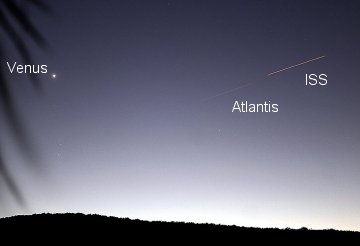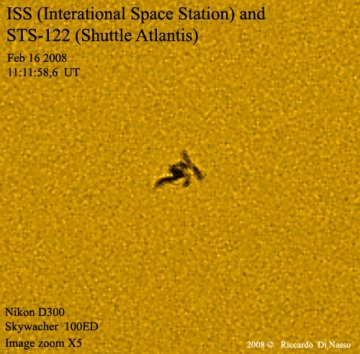| Where's Saturn? Is that a UFO--or the ISS? What's the name of that star? Get the answers from mySKY--a fun new astronomy helper from Meade. | |  | PRESIDENTIAL PROMS: "There are some nice big prominences on the northeast limb of the sun today--President's Day in the United States," reports Greg Piepol of Rockville, Maryland. This snapshot through his SolarMax90 compares the giant, fiery clouds to Earth. Readers with solar telescopes, take a look! SIGHTINGS: This morning at 4:30 a.m. EST, space shuttle Atlantis undocked from the International Space Station. Now sky watchers around the world are seeing the two spaceships side-by-side. "Here they are flying in formation past Venus in early morning twilight," reports Rob Carew of Melbourne, Australia: 
Tonight the flybys continue over the United States. The two spaceships will appear as closely spaced points of light silently gliding in tandem through the twilight sky--an unforgettable sight. Check Heavens Above to find flyby times for your hometown or sign up for easy flyby alerts from Spaceweather PHONE. more images: from Ashmeet Singh of New Delhi, India; from Kevin Baird of San Diego, California; SOLAR TRANSIT: Meanwhile in broad Italian daylight, Riccardo Di Nasso of Pisa recorded a space station flyby ... of the sun: 
"On Feb. 16th, after two years of tests and practice, I finally photographed a transit of the ISS across the sun. (Space shuttle Atlantis is there, too, somewhere in the silhouette.) It was a splendid sunny day; the ISS transited quickly, but right on time," says Di Nasso. He took the picture using a new Nikon D300 and a sun-filtered Skywatcher telescope. more images: from Lynn van Rooijen of Broek in Waterland, the Netherlands ("This may not look like much, but it was a challenge as the total transit of the ISS + Atlantis was less than 1 second!" says van Rooijen.) | 
